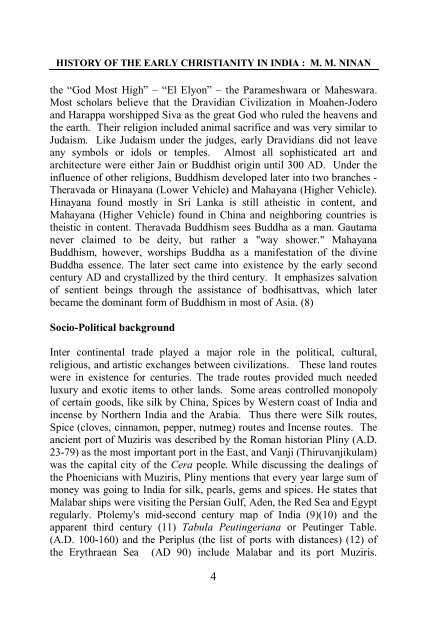History of Early Christianity in India
You also want an ePaper? Increase the reach of your titles
YUMPU automatically turns print PDFs into web optimized ePapers that Google loves.
HISTORY OF THE EARLY CHRISTIANITY IN INDIA : M. M. NINAN<br />
the “God Most High” – “El Elyon” – the Parameshwara or Maheswara.<br />
Most scholars believe that the Dravidian Civilization <strong>in</strong> Moahen-Jodero<br />
and Harappa worshipped Siva as the great God who ruled the heavens and<br />
the earth. Their religion <strong>in</strong>cluded animal sacrifice and was very similar to<br />
Judaism. Like Judaism under the judges, early Dravidians did not leave<br />
any symbols or idols or temples. Almost all sophisticated art and<br />
architecture were either Ja<strong>in</strong> or Buddhist orig<strong>in</strong> until 300 AD. Under the<br />
<strong>in</strong>fluence <strong>of</strong> other religions, Buddhism developed later <strong>in</strong>to two branches -<br />
Theravada or H<strong>in</strong>ayana (Lower Vehicle) and Mahayana (Higher Vehicle).<br />
H<strong>in</strong>ayana found mostly <strong>in</strong> Sri Lanka is still atheistic <strong>in</strong> content, and<br />
Mahayana (Higher Vehicle) found <strong>in</strong> Ch<strong>in</strong>a and neighbor<strong>in</strong>g countries is<br />
theistic <strong>in</strong> content. Theravada Buddhism sees Buddha as a man. Gautama<br />
never claimed to be deity, but rather a "way shower." Mahayana<br />
Buddhism, however, worships Buddha as a manifestation <strong>of</strong> the div<strong>in</strong>e<br />
Buddha essence. The later sect came <strong>in</strong>to existence by the early second<br />
century AD and crystallized by the third century. It emphasizes salvation<br />
<strong>of</strong> sentient be<strong>in</strong>gs through the assistance <strong>of</strong> bodhisattvas, which later<br />
became the dom<strong>in</strong>ant form <strong>of</strong> Buddhism <strong>in</strong> most <strong>of</strong> Asia. (8)<br />
Socio-Political background<br />
Inter cont<strong>in</strong>ental trade played a major role <strong>in</strong> the political, cultural,<br />
religious, and artistic exchanges between civilizations. These land routes<br />
were <strong>in</strong> existence for centuries. The trade routes provided much needed<br />
luxury and exotic items to other lands. Some areas controlled monopoly<br />
<strong>of</strong> certa<strong>in</strong> goods, like silk by Ch<strong>in</strong>a, Spices by Western coast <strong>of</strong> <strong>India</strong> and<br />
<strong>in</strong>cense by Northern <strong>India</strong> and the Arabia. Thus there were Silk routes,<br />
Spice (cloves, c<strong>in</strong>namon, pepper, nutmeg) routes and Incense routes. The<br />
ancient port <strong>of</strong> Muziris was described by the Roman historian Pl<strong>in</strong>y (A.D.<br />
23-79) as the most important port <strong>in</strong> the East, and Vanji (Thiruvanjikulam)<br />
was the capital city <strong>of</strong> the Cera people. While discuss<strong>in</strong>g the deal<strong>in</strong>gs <strong>of</strong><br />
the Phoenicians with Muziris, Pl<strong>in</strong>y mentions that every year large sum <strong>of</strong><br />
money was go<strong>in</strong>g to <strong>India</strong> for silk, pearls, gems and spices. He states that<br />
Malabar ships were visit<strong>in</strong>g the Persian Gulf, Aden, the Red Sea and Egypt<br />
regularly. Ptolemy's mid-second century map <strong>of</strong> <strong>India</strong> (9)(10) and the<br />
apparent third century (11) Tabula Peut<strong>in</strong>geriana or Peut<strong>in</strong>ger Table.<br />
(A.D. 100-160) and the Periplus (the list <strong>of</strong> ports with distances) (12) <strong>of</strong><br />
the Erythraean Sea (AD 90) <strong>in</strong>clude Malabar and its port Muziris.<br />
4


















